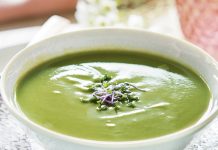Visceral or abdominal fat surrounding the organs is the most dangerous to health, so it should be reduced. We offer you natural remedies that can help you.

People who have too much belly fat live with an increased risk of heart attack and cardiovascular disease. The risk is up to 20 percent higher than for people whose fat is not primarily found in the stomach, but is distributed throughout the body.
Even people with a normal body mass index, who are not considered overweight, but who have abdominal fat in the form of the so-called “lifesaver“, have twice the risk of death and a lower life expectancy, than overweight people who have a more favorable distribution of fat.
WHY BELLY FAT IS SO DANGEROUS
Belly fat is also called visceral fat. It is very dangerous because it also surrounds the internal organs, promotes chronic inflammatory processes, which are an important cause of almost all diseases, and can contribute to metabolic disorders.
Most of those affected suffer from insulin resistance and high blood sugar levels (or already have type 2 diabetes), in addition to an increase in blood lipid levels and, therefore, an overall increased risk of cardiovascular diseases, such as high blood pressure and arteriosclerosis.
However, belly fat can be reduced with a change in diet combined with exercise. A study published in BMC Public Health showed that a change in diet led to a weight loss of 6.1 percent over the course of four months. Along with exercise, weight dropped a little more, by 6.9 percent.
Belly fat decreased by 12 percent in the group that only modified their nutrition and by 14.6 percent in the group that also exercised.
NATURAL REMEDIES THAT REDUCE ABDOMINAL FAT
In addition to exercise (especially weight training) and a healthy diet, you can consume certain foods and supplements that have been shown to be effective in reducing belly fat. These are the 5 foods that destroy abdominal fat and the infusion that will help you maintain the results:
1. COCONUT OIL
Choosing the right dietary fat can make a big difference. You should use high quality virgin coconut oil, if possible extra virgin and organically grown. Its medium-chain fatty acids can help break down belly fat.
In a study conducted at Sains Malaysia University, the waist circumference of 20 overweight subjects decreased by an average of 2.86 centimeters after 4 weeks when incorporating coconut oil into their diet.
In another study, 40 women in their 20s and 40s dieted and walked 50 minutes a day. In addition, they received soybean oil or coconut oil as a dietary supplement.
After 12 weeks, both groups had a lower BMI, but only the coconut oil group also had a smaller waist size, which speaks to abdominal fat loss. In the soybean oil group, the cholesterol level had also worsened, which was not the case in the coconut oil group.
2. TURMERIC
Curcumin is the active ingredient in turmeric. It is a powerful antioxidant, possesses anti-inflammatory properties and can increase basal metabolic rate, which leads to increased energy consumption and therefore reduced body weight and metabolic health.
In a 2019 meta-analysis, researchers examined 21 studies and concluded that regular curcumin intake could not only significantly reduce BMI, but also waist circumference.
The daily dose of curcumin was between 500 and 2,400 mg.
3. GRAPEFRUIT
Grapefruits are very healthy fruits. They are not too sweet, provide bitter and antioxidant substances, and have anti-inflammatory properties.
Grapefruit can also help with abdominal fat loss. In one study, participants were asked to eat half a pink grapefruit three times a day, with each main meal for 6 weeks.
Compared to the control group that did not eat grapefruit, the study participants had lost an average of 2.45 centimeters from the waist.
The welcome side effect was that grapefruit also lowered blood pressure (systolic) by about 3.2 mmHg.
Keep in mind that grapefruits can increase the effects of medications and therefore their side effects.
4. DARK CHOCOLATE
Cocoa is extremely rich in antioxidants. Consequently, so is any chocolate with a high cocoa content (at least 70 percent). As in green tea, cocoa antioxidants include polyphenols, for example flavanols, epicatechin and procyanidins.
In a clinical study with 44 diabetics, one group received 30 g of dark chocolate daily for 8 weeks, while the control group received no chocolate. Waist circumference in the chocolate group decreased by an average of just under a centimeter, body fat percentage decreased and lean body mass increased.
Lean body mass includes muscle mass and everything else (except fat), i.e., organs, body water, etc. Blood pressure could also be significantly reduced. The systolic value decreased by approximately 7 mmHg and the diastolic value by almost 6 mmHg.
5. MUSHROOMS
Many people suffer from vitamin D deficiency, even in our sunny country. This deficiency is one of the reasons why overweight people cannot lose pounds.
In addition, vitamin D deficiency promotes fat storage in the abdomen and around internal organs. Studies have already shown that the more belly fat a person has, the lower their vitamin D level and the less muscle mass they have.
In a double-blind, placebo-controlled study of 171 participants average 40 years of age, half received three 240 ml glasses of orange juice enriched with 350 mg of calcium and 100 IU of vitamin D or regular orange juice (with no added vital substances) for 16 weeks.
Weight loss was similar in both groups (average of 2.45 kg), but the calcium and vitamin D group was able to significantly reduce more belly fat.
In addition to fortified foods (such as juices, juices, milks, cereals …) some foods such as mushrooms (including mushrooms) are rich in vitamin D.
Before taking vitamin D, measure your levels, then take the required individual dose.
GREEN TEA
Green tea contains large amounts of plant substances from the group of polyphenols (catechins). These substances are responsible for the numerous health benefits enjoyed by regular green tea drinkers.
Green tea catechins (the most studied being EGCG, epigallocatechin gallate) protect against cancer, are useful in arthritis, help improve memory, and are used therapeutically for fibroids, to name just a small selection of their properties.
Green tea also helps with weight loss, especially when it comes to breaking down belly fat.
Catechins accelerate energy metabolism and thus reduce weight and body fat percentage. Abdominal fat in particular and fat surrounding organs within the body respond well to green tea or green tea extracts that are rich in catechins.
In a study conducted with 182 overweight adults, they were given one of the following drinks or drink combinations for 90 days:
- Control group: 2 control drinks with 30 mg of catechins and 10 mg of caffeine per day.
- Group 1: 1 control drink and 1 serving of extra green tea rich in catechins (458 mg of catechins and 104 mg of caffeine per day)
- Group 2: 2 servings of catechin-rich green tea (468 mg catechins, 126 mg caffeine)
- Group 3: 2 servings of extra green tea rich in catechins (886 mg catechins, 198 mg caffeine).
In group 3, a significant reduction in abdominal fat (by 5.6 cm2) was observed compared to the control group. Waist circumference also decreased by almost 2 cm.
Catechins account for up to 40 percent of the dry matter in green tea. Korean and Japanese green teas, especially in semi-shade Japanese teas and high-quality matcha tea, are the richest in catechins.
In addition to considering food, it is important to do exercises to reduce abdominal fat. It is important to do them correctly to avoid lumbar, cervical, perineum and belly wall injuries.
And, in addition, so that they help to put the belly and do not get the opposite effect, which is what happens when the trunk is flexed forward in a poorly done abdominal or when the glottis is blocked in an intense exercise.
MYTHS ABOUT ABS: TRUTH OR LIE?
Many myths circulate about abs.
- The truth is that its strength alone is insufficient to obtain a “flat stomach”. That gut comes out can be related to a multitude of factors.
- Some abdominal exercises also narrow the waist but do not flatten the belly, because they focus on working the obliques.
- On the other hand, constantly contracted abdominals (not only worked in the gym) can hinder the motility and proper functioning of the abdominal viscera. Therefore, it is good to learn to relax the abdomen and do it at various times throughout the day.
What should we consider to exercise the abs well and get a flat stomach?
To achieve a smoother belly, you can work the abdominals following some indications:
- With an upward contraction, starting at the bottom to go up, and not the other way around because you can put too much pressure on the perineum and favor prolapses and urinary incontinence.
- If the abdominals are contracted in an expiration, it must be done by ascending the abdomen and not descending the ribs.
- Whenever possible it is better to tone the abdominals at the same time as the dorsals. There are exercises that involve both groups to support the pelvis.
SIMPLE EXERCISE TO CONTRACT STRAIGHT ABS
- Lie on your back, with your arms along your body, your knees and ankles bent, and your feet on the floor.
- With an inspiration, raise your legs until they form a right angle to your hips, keeping your knees bent.
- When exhaling, lower your legs to the floor.
- Repeat 5 times.
With this exercise the contraction of the anterior straight abdominals, those in front, is worked. The difficulty increases if the extended legs are raised.
Scientific references:
- Liau et al. An open-label pilot study to assess the efficacy and safety of virgin coconut oil in reducing visceral adiposity. ISRN Pharmacology
- Assunção et al. Effects of dietary coconut oil on the biochemical and anthropometric profiles of women presenting abdominal obesity. Lipids.
- Van Gemert et al. Effect of diet with or without exercise on abdominal fat in postmenopausal women – a randomized trial. BMC Public Health.
- Akbari et al. The Effects of Curcumin on Weight Loss Among Patients with Metabolic Syndrome and Related Disorders: A Systematic Review and Meta-Analysis of Randomized Controlled Trials. Frontiers in Pharmacology.
- Dow et al. The effects of daily consumption of grapefruit on body weight, lipids, and blood pressure in healthy, overweight adults. Metabolism.
- Wang et al. Effects of catechin enriched green tea on body composition. Obesity.
- Ayoub et al. Protective Effect of Dark Chocolate on Cardiovascular Disease Factors and Body Composition in Type 2 Diabetes: A Parallel, Randomized, Clinical Trial. Iranian Red Crescent Medical Journal.
- Rosenblum et al. Calcium and vitamin D supplementation is associated with decreased abdominal visceral adipose tissue in overweight and obese adults. American Journal of Clinical Nutrition.








